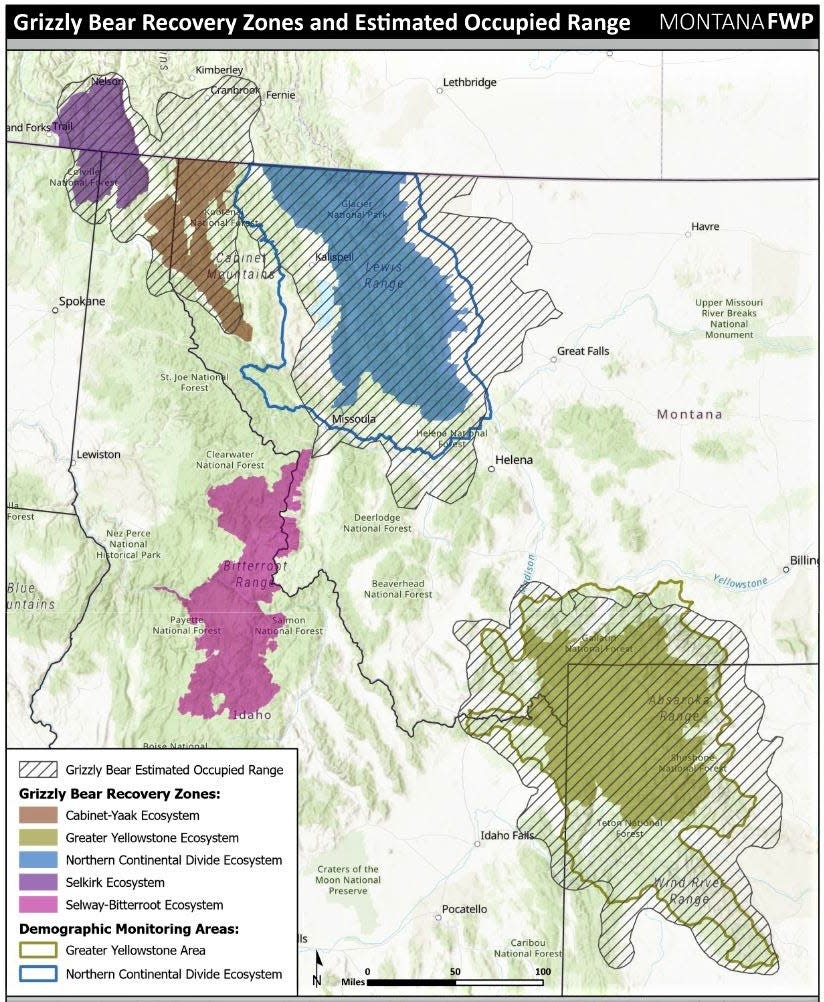Grizzly bear shot, killed after charging man northwest of Wolf Creek
A man searching for antlers on private land northwest of Wolf Creek shot and killed a grizzly on April 25 after the bear charged him coming within 10 feet.
Montana Fish, Wildlife and Parks (FWP) announced on Friday that the man, who remains unidentified, was walking along a ridge covered with low trees and brush with his two dogs at his side and the wind at his back.
“After seeing a fresh grizzly bear track in a snow patch, he continued along his path," a statement said. "A few minutes later he first saw the bear, standing near the top of the ridge about 20 yards away. The bear dropped to all four legs and charged the man, who drew his handgun and fired five shots from distances of about 30-feet to 10-feet.”
The man grazed the bear with one shot, before hitting and killing it with another. He was not injured in the encounter. He was not carrying bear spray at the time.
FWP officials said the adult female grizzly was in good condition, weighing around 300 pounds estimated to be 12 years old. The bear had a single three-month old cub nearby that was later captured by FWP bear management specialists. The cub was taken to FWP’s wildlife rehabilitation center in Helena, and FWP is looking for an accredited zoo that will accept the cub.
FWP Bear Specialist Chad White said the incident did not occur in the proximity of any houses, with the closest being one to two miles away. He added that bears in this area first began emerging from hibernation about two months ago.
“We first started seeing lone adult males come out in March, but typically females with cubs don’t come out until later,” White said. “It’s hard to say how long that female had been out on the ground.”
FWP notes that grizzly bear populations continue to become denser and more widespread across the state, increasing the likelihood that residents and recreationalist will encounter them in more places each year. In recent years FWP officials have confirmed grizzly bear sightings in the Big Snowy Mountains south of Lewistown, the Bears Paw Mountains south of Havre, and the Pryor Mountains south of Billings – places grizzlies have not occupied since the late 1880s.

“FWP has recently worked to increase grizzly bear awareness in northcentral Montana, including public presentations in both Havre and Big Sandy in the last few years,” the news release states. “All hunter, bowhunter and trapper education students in the state are taught about bear safety and the effective use of bear spray, and great information can be found online at fwp.mt.gov/bear-aware on how to live and recreate in bear country.”
“Much of central and north central Montana is cattle country,” said Drew Henry, FWP Supervisor for Region 6. “If producers are worried about bear conflicts or need help securing their property, please reach out to us. We’ve got a number of tools that can be useful in helping landowners avoid bear conflicts.”
Grizzly bears remain a federally protected species under the Endangered Species Act, even though their populations have recovered beyond targeted population levels in two of the six grizzly bear recovery areas. The Northern Continental Divide Ecosystem which is the home of Glacier National Park and extends across 9,600-square-miles is believed to contain more than 1,100 grizzlies, while the Greater Yellowstone Ecosystem, a 9,200-square-mile area shared by Wyoming, Montana and Idaho is thought to be home to around 900.
“If drought conditions of the past months continue into the summer there will be a higher chance of a failed berry crop this year, which will have bears searching for more non-natural foods to meet their nutritional requirements,” said Conrad area bear management specialist Wesley Sarmento. “In a dry year like this, ensuring that any attractants are secured is especially important for keeping bears away from homes, so it’s always a focus for us to work with homeowners and ag producers to help minimize the potential for conflicts.”
Be bear aware
Avoiding conflicts with bears is easier than dealing with conflicts. Here are some precautions to help residents, recreationists and people who work outdoors to avoid negative bear encounters:
Carry bear spray and be prepared to use it immediately.
Travel in groups whenever possible and make casual noise, which can help alert bears to your presence.
Stay away from animal carcasses, which often attract bears.
Follow food storage orders from the applicable land management agency.
If you encounter a bear, never approach it. Leave the area when it is safe to do so.
Keep garbage, bird feeders, pet food and other attractants put away in a secure building. Keep garbage in a secure building until the day it is collected. Certified bear-resistant garbage containers are available in many areas.
Never feed wildlife. Bears that become food conditioned lose their natural foraging behavior and pose threats to human safety. It is illegal to feed bears in Montana.
Grizzly bears in the lower 48 states are listed as threatened under the Endangered Species Act. Management authority for grizzlies rests with the U.S. Fish & Wildlife Service, working closely in Montana with FWP, the Forest Service, the National Park Service, the Bureau of Land Management, the U.S. Geological Survey, Wildlife Services, and Native American tribes. This collaboration happens through the Interagency Grizzly Bear Committee.
This article originally appeared on Great Falls Tribune: Grizzly bear shot, killed after charging man northwest of Wolf Creek

